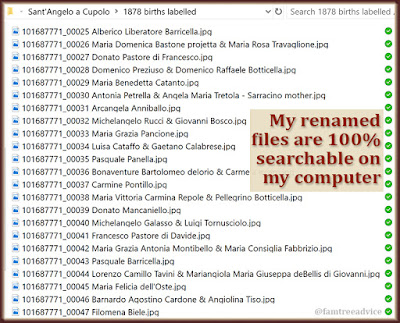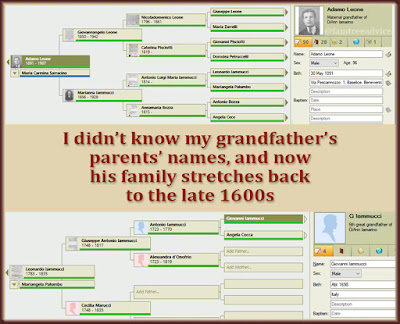Nothing interests me more than harvesting this rich genealogy resource.
All I need is my laptop and a working electrical outlet to be endlessly happy.
That's because I have an enormous resource for building my family tree on my laptop. You see, all my ancestors come from a handful of neighboring towns in southern Italy. For most of my life, this was all I knew:
- my Grandpa Leone was born in Baselice
- he had a brother Noah and a sister Eve, which was funny because he was Adam
- my Grandpa Iamarino was born in Colle Sannita
- he had a sister called Susie, and his parents were Francesco Iamarino and Libera Pilla
- my maternal grandmother Mary was born in New York City to parents from Pastene
- her mother's siblings and parents lived in the Bronx, New York
- my paternal grandmother Lucy was born in New York state to Pasquale Iamarino and Maria Rosa something
When I started working on my family tree, there was only one resource for Italian documents. I had to order and view microfilm at a local Family History Center. I spent 5 years viewing and transcribing (in my own shorthand) all the vital records from Baselice.
I built my Grandpa Leone's family tree going back 6 generations.
The whole time I was doing that, I was eager to do the same for my other ancestral hometowns. But 5 years per town is an awful lot of trips to a Family History Center.
That all changed 3 years ago. Digitized images of Italian vital records started coming online!
One of my 2020 genealogy goals involves a family from the hamlet of Pastene in the town of Sant'Angelo a Cupolo. So I'm going to start doing for Sant'Angelo a Cupolo what I did for Baselice…in MUCH less time.
 |
| Using these documents, I can paint a detailed picture of my direct ancestors' hometowns. |
Here's my plan. If you have access to a collection of vital records from your ancestral hometowns, you should do the same.
1. Rename the Document Images
I've got a folder of Italian vital records on my computer. It's simultaneously backed up to OneDrive, too.
In the main folder there's a folder for each of the 2 provinces where I have roots: Benevento and Avellino. In each of the province folders are different town folders. In each town folder are as many as 225 folders. That's 1 folder for each year's birth records, 1 for death records, and 1 for marriage records.
Sant'Angelo a Cupolo has only 72 folders because there are no records before 1861. Recently I renamed the images in 21 of the 72 folders to include the name of the subject(s).
Until I rename the document images, the people in all those folders are hidden from me. As I rename files, I'm discovering relatives. I found children born to my 2nd great grandmother's sister. I found my 2nd cousin 3 times removed. I found a branch of my Sarracino family that I can't connect to my family tree yet.
 |
| It doesn't take all that long to rename the document images, and then they're searchable. |
All these people are discoverable the moment I rename their document image file.
2. Learn the Names
Each time I start renaming files from another town, I have many more names to learn. Lots of times I'm unsure of the spelling. But when I see the name written on several documents, they become clearer to me.
Learning the names from my ancestral hometowns is key to figuring out who most of my DNA matches are. I start by looking at their (all-too-often) sparse family tree for a familiar last name.
When I spot a name like Pilla or Cocca, I know it could be from Grandpa Iamarino's town. A name like Petruccelli or Bozza could be from Grandpa Leone's town. This familiarity is so important. I can decipher a badly written name on a document because I know which names come from that town.
3. Piece Families Together
When I began those 5 years of microfilm viewing, I realized something important. I couldn't tell which people were my direct ancestors until I put families together.
I have 8 people from the town named Giovanni Pisciotti. They're all in my family tree, and some were born only a few years apart. How could I know which one was my 3rd great grandfather? I had to build each family in town.
 |
| Piecing together my grandfather's entire town? Well worth it! |
Using my collection of vital records, I can build out every little branch of my family tree. I love doing that for my 19th century Italians. But when it comes to modern times in the USA, I decided to cut off in-law trees at their parents.
For example, I'll give my 2nd cousin her husband and their wedding date. And I'll give her husband his parents. But that's it. He gets no siblings and no grandparents.
My indulgence is with my multitude of small-town Italians. These twisted and distant relationships are going to be what ties me to a DNA match. Plus, I adore their names more than I can say.
Thanks to the documents, I turned what would be a 2,000-person tree into a 23,000-person tree, and growing. All those names (all those souls!) give me a connection to my ancestral hometowns. Even today I see people online from my towns with names I know so well.
So here I am, starting my journey into another one of my ancestral hometowns. I'll learn their names as I rename their files, and start fitting people into my family tree. Remembering my 2020 genealogy goal, I'll pay extra attention to people with name Muollo.
Don't let anyone tell you who does and doesn't belong in your family tree. This is your hobby, and we each have our reasons for dabbling in genealogy. I hope you've found a purpose that makes you as excited about genealogy as I am.
No comments:
Post a Comment